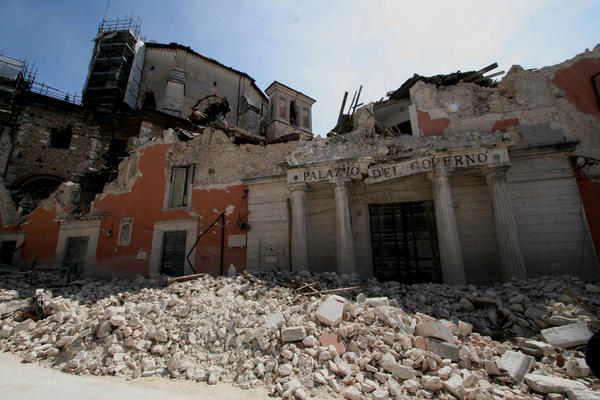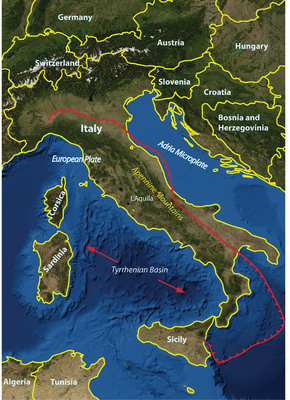
by Carolyn Gramling Thursday, January 5, 2012

Many of L'Aquila's buildings were reduced to rubble during the April 6 earthquake. INGV

The Adria Microplate is sliding beneath the European Plate (jagged red line); the subduction tugs the European Plate eastward, causing faulting that produces earthquakes. AGI
Early on the morning of April 6, 2009, a magnitude-6.3 earthquake rocked the Apennine region of central Italy, killing more than 290 people and leaving at least 30,000 homeless. Some 15,000 buildings were damaged or destroyed in L’Aquila, the largest city in the region. Although strong, the earthquake was not powerful enough to easily account for the high loss of life in a developed country. The devastation has prompted some researchers to investigate Italy’s seismic safety codes for new construction — but the problem may have more to do with retrofitting older buildings.
A 2008 report by researchers at Italy’s National Institute of Geophysics and Volcanology, which has an observatory in L’Aquila, labeled nearly half of the country as “dangerous” when it comes to seismic activity. But according to the report, only 14 percent of the buildings in those seismically dangerous areas are built to seismic safety standards.
The issue is not that Italy has been lax in devising building codes, however, says Andrei Reinhorn, a civil engineer with the Multidisciplinary Center for Earthquake Engineering Research, based at the University at Buffalo in New York. Seismic safety standards for buildings in European Union countries, including Italy, are set by the European Committee for Standardization, with local modifications made in each country. The “EuroCode,” Reinhorn says, is continuously evolving and being updated every two to three years. Italy, he adds, is among the most “truly advanced countries in earthquake engineering.”
What happened in L’Aquila is somewhat more complicated than poor building codes, Reinhorn says. One problem is that there is no law in Italy that stipulates applying seismic building codes retroactively to existing buildings, even if other repairs are being made. In the United States, he says, if there is retrofitting for some other purpose, then at the same time, seismic retrofitting will be done. “But in Italy, there is no such law.” And repairs and updates are extremely expensive, so many people do not do them, he says.
Another problem is the challenge of appropriately classifying the seismic danger to L’Aquila and other regions of Italy. The country’s geology and tectonic activity are complex: A microplate, Adria, located to the east of Italy, is slowly subducting beneath the Apennine Mountains; to the north, the Eurasia and Africa plates continue to collide and push up the Alps; and to the west, the Tyrrhenian Basin is opening up. The L’Aquila earthquake — actually the largest of hundreds of events that occurred over several days, including three large aftershocks — occurred as a result of the opening of this basin, causing a rupture along a normal fault in the central Apennine Mountains, which extend from the Po Basin in northern Italy to the Gulf of Taranto in the south.
After a reassessment of this complex geology three years ago, L’Aquila’s seismic danger was upgraded from moderate to severe. As a result, building codes in the region were only recently upgraded as well — and thus buildings erected in the last 30 or 40 years were not built to the strictest codes. Even so, many of those buildings fared better than many medieval and Renaissance stonemasonry structures.
Enforcing seismic building codes for new construction is important, Reinhorn says — but he adds that there is little evidence that enforcement is a problem. Instead, “if the local government is interested in preventing future loss of life, [they will also need to] inspect existing buildings and identify the vulnerability of those buildings,” he says. The government should “request that those be retrofitted at least with minimal conditions,” which would be less expensive than full retrofitting.
Meanwhile, much of the center of L’Aquila, a city of 73,000 people, remained closed off for at least a month after the earthquake, as inspectors continued to investigate the structural damage to buildings and assess the danger. The historical loss is great — many of the oldest buildings, constructed over centuries, were among the most severely damaged. But the loss to modern life is also great, Reinhorn says. “For European cities, the whole life is in the center of the city,” and it is not clear how long the city will remain shuttered, he says. “There is a possibility of repair and restoration, but this will take a lot of money.”
© 2008-2021. All rights reserved. Any copying, redistribution or retransmission of any of the contents of this service without the expressed written permission of the American Geosciences Institute is expressly prohibited. Click here for all copyright requests.